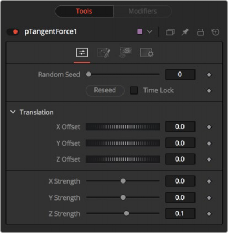
< Previous | Contents | Next >
Selecting this checkbox causes particles created by spawning to also become affected by the pSpawn node on subsequent frames. This can exponentially increase the number of particles in the system, driving render times up to an unreasonable degree. Use this checkbox cautiously.
This control determines how much velocity of the source particle is transferred to the particles it spawns. The default value of 1.0 causes each new particle to adopt 100 percent of the velocity
and direction from its source particle. Lower values will transfer less of the original motion to the new particle.
Common Controls
The Conditions, Style, Region, and Settings tabs are common to all Particle nodes, so their descriptions can be found in “The Common Controls” section at the end of this chapter.
pTangent Force [pTF]

The pTangent Force node
![]()
pTangent Force Node Introduction
This node is used to apply a tangential force to the particles—a force that is applied perpendicularly to the vector between the pTangent Force’s region and the particle it is affecting.
Inputs
The pTangent Force node has a single orange input by default. Like most particle nodes, this orange input accepts only other particle nodes. A green bitmap or mesh input appears on the node when you set the Region menu in the Region tab to either Bitmap or Mesh.
— Input: The orange input takes the output of other particle nodes.
— Region: The green or magenta region input takes a 2D image or a 3D mesh depending on whether you set the Region menu to Bitmap or Mesh. The color of the input is determined by whichever is selected first in the menu. The 3D mesh or a selectable channel from the bitmap defines the area where the tangent force effects the particles.
Basic Node Setup
The pTangent Force node is inserted between a pEmitter and a pRender node.

The pTangent Force node positions a tangent force that particles maneuver around.
Inspector

The pTangent Force controls
![]()
The controls for this node are used to position the offset in 3D space and to determine the strength of the tangential force along each axis independently.
The Random Seed slider and Randomize button are presented whenever a Fusion node relies on a random result.
Two nodes with the same seed values will produce the same random results. Click the Randomize button to randomly select a new seed value, or adjust the slider to manually select a new seed value.
These controls are used to represent the X, Y, and Z coordinates of the Tangent force in 3D space.
These controls are used to determine the Strength of the Tangent force in 3D space.
Common Controls
The Conditions, Style, Region, and Settings tabs are common to all Particle nodes, so their descriptions can be found in “The Common Controls” section at the end of this chapter.